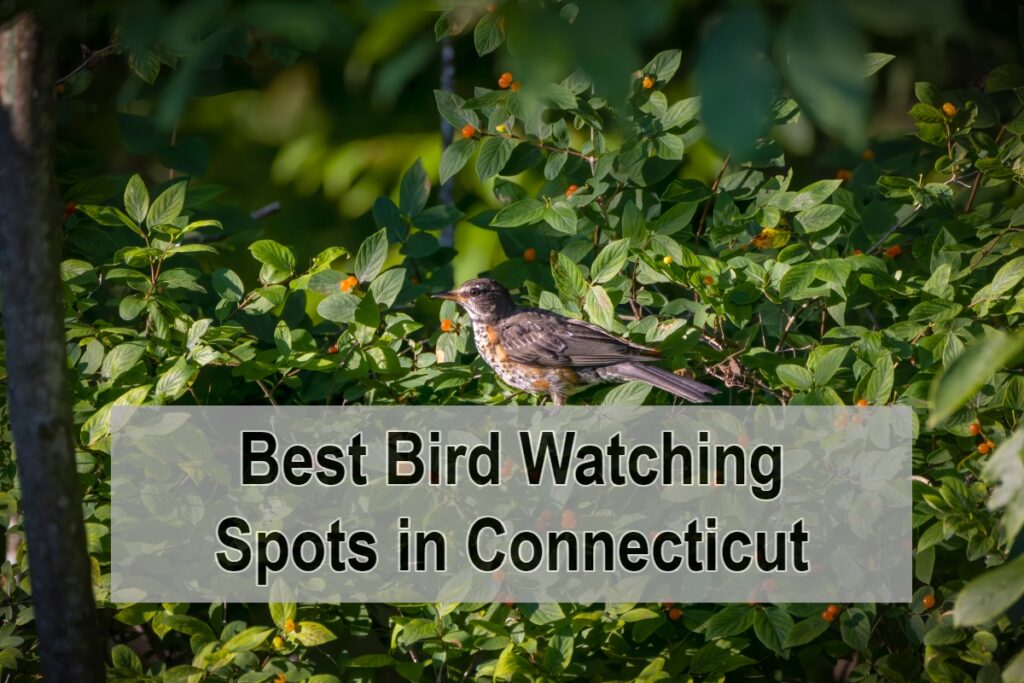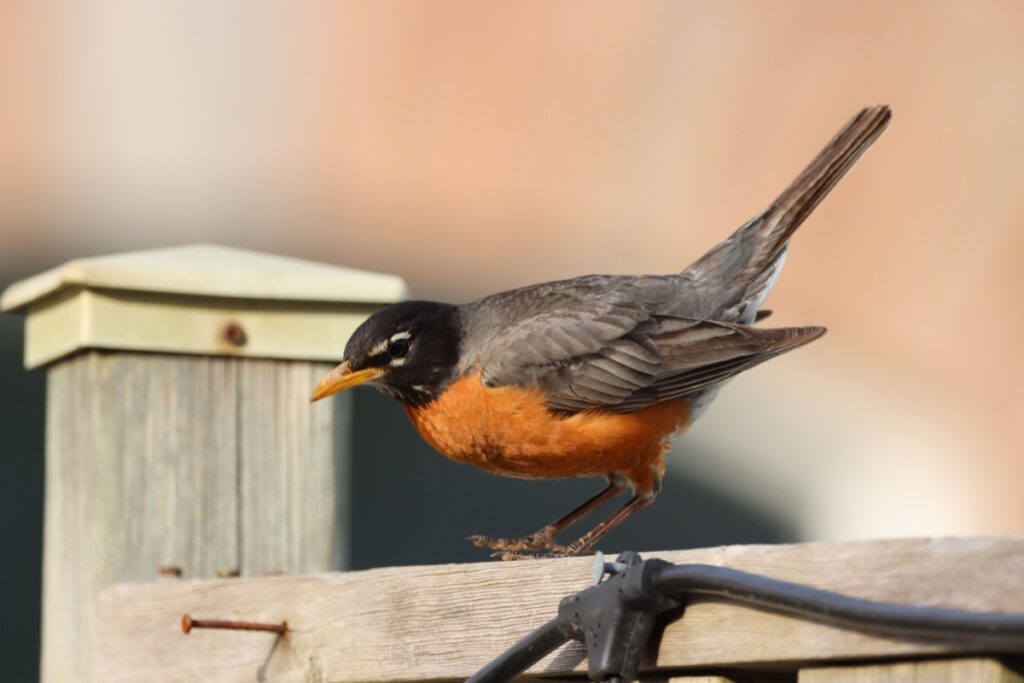As an Amazon Associate, we earn from qualifying purchases with no additional costs for you.
Connecticut is not a big state, but it still has at least 400 species of birds that have been recorded. It is not always easy to know the best bird watching places to visit, which is why I put together this list of my best birding spots in Connecticut.
The best bird watching spots in Connecticut are those along the coast, such as Harkness Memorial Park and Hammonasset Beach State Park. Excellent birding is also found where there is habitat diversity, such as at the Audubon Center in Greenwich and Stratford Point.
Table giving the most interesting birds you can see at each of my top 10 birding spots in Connecticut:
| PARK | INTERESTING BIRDS YOU CAN SEE |
|---|---|
| Harkness Memorial State Park | American Oystercatcher and Ruddy Turnstone |
| Hammonasset Beach State Park | Piping Plover and Least Tern |
| White Memorial Foundation | Common Merganser and Redhead |
| Stratford Point | Semipalmated Plover and Long-tailed Duck |
| East Rock Park in New Haven | Northern Waterthrush and Canada Warbler |
| Yale Myers Forest | Ruffed Grouse and Virginia Rail |
| Station 43 | Least Bittern and American Bittern |
| Mansfield Hollow State Park | Blue-winged Warbler and Whip-poor-will |
| Audubon Center in Greenwich | Scarlet Tanager and Worm-eating Warbler |
| Sherwood Island State Park | Golden-winged Warbler and American Pipit |
Read further to find more information on the locations and birds you can see in Connecticut.
TIP: If you want to check out the best pair of binoculars for bird watching, we recommend a pair of waterproof and fog-proof 8 x 42 binoculars like the Celestron – Outland X 8×42 Binoculars (Amazon link).
Best Places to Bird Watch in Connecticut
Connecticut is only 110 miles in length, east to west, but it still has many good habitats and places where you can see birds.
1. Harkness Memorial State Park
This state park is located in Waterford, and it is 304 acres in size. A checklist of the 260 species is available for use on your trip here.
Several species of shorebirds, terns, and gulls have been recorded here. Some of the shorebirds include the following species: Stilt Sandpiper, American Oystercatcher, Semipalmated Sandpiper, Marbled Godwit, Short-billed Dowitcher, Red Knot, and Ruddy Turnstone.
Gulls seen here include Black-legged Kittiwakes, Iceland Gull, Black-headed Gull, Herring Gull, and Ring-billed Gull. Roseate Terns, Forster’s Terns, and Royal Terns have also been recorded in the area.
In the ocean, you can find Common Eider, Brant, Common Goldeneye, and Mallard. These birds are often more likely to be seen in winter. This is also true for Snowy Owls, which may appear during some years.
On land, migrating songbirds can be found. Some of these birds include Yellow-throated Vireos, Warbling Vireos, Tennessee Warblers, Blue-winged Warblers, and Black-white Warblers.
TIP: Knowing how to spot the birds in your yard is key to enjoying visits from your winged friends as much as possible! The best sources are trusted books, I recommend using the following (Amazon links):
– National Geographic Field Guide to the Birds of North America
– National Audubon Society Birds of North America
2. Hammonasset Beach State Park
The area is designated as an important bird area. It has a variety of habitats, including beaches, upland forests, and brackish marshland. This area is a good place for Piping Plovers and Least Tern, both species of conservation concern that nest here on the beach area.
The marshes are where you can find Saltmarsh Sparrows, which breed in the area. You can find several grassland birds like the Upland Sandpiper, American Golden Plover, Black-bellied Plover, and Buff-breasted Sandpiper.
The cedar trees and shrubs provide habitats for other birds. You can also find Barn Owls, Long-eared Owls, and Saw-whet Owls in this park.
3. White Memorial Foundation
This 4,000-acre area has a variety of habitats, including vernal ponds, grasslands, wetlands, evergreen forests, deciduous forests, and shrubby areas. The result is a high diversity of birdlife. AT least 4 species of owls can be seen here as well.
On the wetlands, many thousands of waterfowl can be seen during migration, including American Black Ducks, Common Mergansers, Pied-billed Grebes, American Coot, and Redheads.
You should look out for Least Bittern and American Bittern in the marshy areas of the wetlands. Raptors that have been seen in the area include Sharp-shinned Hawks, Cooper’s Hawks, and American Kestrels.
4. Stratford Point
This coastal sanctuary is situated near the Housatonic River mouth. There is a salt marsh, open water, rocky shores, and grasslands.
The waters attract winter birds like the Long-tailed Duck. Northern Harriers may also be seen during this time, flying low over the grasslands and marshy areas.
It is a favorite spot for some shorebirds like the Least Sandpipers, White-rumped Sandpipers, Black-bellied Plovers, Spotted Sandpipers, Baird’s Sandpipers, Short-billed Dowitchers, Semipalmated Sandpipers, and Semipalmated Plovers.
Bantam Lake, which is found here, attracts many waterfowl such as Redheads, Blue-winged Teals, Canvasbacks, American Black Ducks, Green-winged Teal, and American Coots. You can also find Brant and Mute Swans in the waters.
There are about 35 miles of trails and boardwalks in the area that you can use while bird watching the site. There is an illustrated bird species checklist that you can use for your trip here.
5. East Rock Park in New Haven
This park is in the city of New Haven and is another important bird area. Over 200 species of birds have been recorded at East Rock Park. It is a good place for migrating birds, which stop over every year.
There is a rocky ridge and woodlands that attract many birds. The area also has a trail you can walk along. Some of the songbird species found here include Magnolia Warblers, Nashville Warblers, Northern Waterthrushes, Canada Warblers, Rose-breasted Grosbeaks, and Worm-eating Warblers.
You should keep an eye out for Swamp Sparrows and Field Sparrows. You can also find Wild Turkeys and American Woodcocks on the ground in the park.
Bald Eagles and Osprey have been recorded in this park before, so you should keep an eye out for these species and other raptors. Peregrine Falcons sometimes nest on the rocky ridge. This is also a good spot to see Common Ravens.
A species checklist is available for this park, which is a helpful starting point for any birder visiting the area.
TIP: Check out my recommended products if you are looking for the best and trusted equipment for birdwatching in the wild or on your backyard (Amazon link):
- Celestron Outland X 8×42 Binoculars
- Celestron Ultima 80 Angled Spotting Scope
- National Audubon Society Birds of North America Book
- Design Free-standing Bird Bath
- Smart Bird Feeder with Camera
- Cedar Bird House for Outside
6. Yale Myers Forest
This is a 7,840-acre property that is comprised of mixed forests. There are hardwoods, red pine plantations, and white pine areas.
The area attracts many species of birds, making this a good spot for any bird watcher. At least 156 bird species have been observed in the Yale Myers Forest region.
Virginia Rail has been recorded breeding in the refuge. Some of the species recorded here include Northern Waterthrush, Louisiana Waterthrush, Pine Warbler, Eastern Phoebe, Blue-headed Vireo, Common Raven, and American Redstart. You can also see Wood Thrushes and Veerys here; they are often in the forest’s undergrowth.
Warblers have been found in the forest, including species like the Northern Parula, Black-throated Green Warbler, Black-and-white Warbler, Cerulean Warbler, Cape May Warbler, Chestnut-sided Warbler, and Blackburnian Warbler. Broad-winged and Red-shouldered Hawks occur here; in summer, you can see Common Nighthawks.
7. Station 43 Wildlife Sanctuary
This is a 43-acre area wildlife sanctuary managed by the Hartford Audubon Society. It has a freshwater pond and wetland area. It is part of the Connecticut River Floodplain. The marshland here is where both the American Bittern and Least Bittern nest. Marsh Wrens and Virginia Rail also breed here.
Rusty Blackbirds stop here in winter, and many other birds migrate through this area. Bald Eagles have been seen in the area as well. At least 231 species of birds have been recorded in this area.
You can see waterfowl species, such as Wood Duck, Blue-winged Teal, Mallard, Green-winged Teal, American Wigeon, Bufflehead, Red-breasted Merganser, Common Merganser, and Hooded Merganser.
Wading birds like Tricolored Herons and Great Egrets can be spotted at the water’s edge. You can also find several passerine species, such as Golden-crowned Kinglets, Blue-headed Vireos, Red-eyed Vireos, Magnolia Warblers, and Black-throated Green Warblers.
8. Mansfield Hollow State Park
This park includes different habitats, including a reservoir, mudflats, deciduous and evergreen forests, open grasslands, and fields. This park is essential in providing a good place for many birds to nest.
Some birds that breed in the park include Whip-poor-wills, Blue-winged Warblers, and Prairie Warblers. At least 180 species of birds have been recorded at Mansfield Hollow State Park. A species checklist is available for you to use.
Several species of waterfowl have been recorded on the reservoir, including the following: American Black Duck, Long-tailed Duck, Common Merganser, Wood Duck, Green-winged Teal, and Blue-winged Teal.
Shorebirds to watch for on the muddy areas of the lake include Whimbrel, Solitary Sandpiper, Long-billed Dowitcher, Least Sandpiper, Pectoral Sandpiper, and Dunlin. In the marsh areas, you should look for King Rails and American Bitterns.
Golden Eagles, Bald Eagles, and Osprey have been recorded from this state park. Many species of swallows have been seen here, such as the Northern Rough-winged and Tree Swallows.
9. Audubon Center in Greenwich
This is a 285-acre sanctuary with 7 miles of trails you can hike while looking for birds. The area has wetlands, forests, meadows, and fields, which attract several different types of birds.
Some notable species here include the Scarlet Tanager, Baltimore Oriole, Yellow-throated Vireo, and Worm-eating Warbler.
Several songbirds can be seen here, such as Palm Warblers, Black-and-white Warblers, American Redstarts, and Ovenbirds.
Yellow Warblers, Waterthrushes, Indigo Buntings, and Rose-breasted Grosbeaks have been seen in this refuge at times as well. During migration, you could see other warblers and vireos.
You can sometimes find Ruffed Grouse and Wild Turkey on the ground. Red-shouldered and Red-tailed Hawks have been observed here, and even birds rare to the area, such as the Rough-legged Hawk, have been seen here.
There is a brochure and checklist of the birds here that you can download and print to give you an idea of what species are most common during what times of the year.
TOP TIP: Some birds are far friendlier than others, making them much easier to find. Some of the easiest and most friendly birds to find can be found here. To learn about how to get the best bird watching experience all year, take a look at this article.
10. Sherwood Island State Park
This is a 235-acre park on the shore of Long Island Sound near Westport, Connecticut. There are various habitats here, such as wetlands, salty marshes, woodlands, grasslands, and beaches.
Many bird species are at Sherwood Island State Park, including the American Pipit, Snow Bunting, and Great-horned Owls.
A total of 284 bird species have been recorded in this park, making this a worthwhile trip for any birder. Several songbirds can be seen here at various times, including the following species: Chestnut-sided Warbler, Yellow Warbler, Northern Parula, Golden-winged Warbler, and Tennessee Warbler.
In the open water, you can find birds like the Red-throated Loon, Horned Grebe, Red-necked Grebe, and Common Loon. Waders include Tricolored Herons, Great Blue Herons, Green Herons, Snowy Egrets, and Great Egrets.
Shorebirds you can find here include species such as Spotted Sandpipers, Greater Yellowlegs, Lesser Yellowlegs, Solitary Sandpipers, Ruddy Turnstones, and Marbled Godwits. Ring-billed Gulls and Herring Gulls are the commonest of the gull species, but several uncommon and rare species have also been recorded here at various times.
Best Time to Bird Watch in Connecticut
People regularly bird watch in Connecticut, but some times of the year are best for certain types of birds.
| TYPES OF BIRDS | SEASON |
|---|---|
| Mergansers | December |
| Warblers | May and June |
The Connecticut State Bird
The Connecticut State Bird is the American Robin. This is a bold bird that is easy to recognize and can be seen often in suburban gardens.
The bird has orange underparts and brown upper parts. Robins often run along the lawn, looking for invertebrates like snails and earthworms to eat.
They are mainly carnivorous, but they will eat berries, insects, and other invertebrates. Although the bird is called a robin, it is actually a type of thrush and is in the family Turdidae.
Bird Watching Laws in Connecticut
It is illegal to catch, have, or harm any wild bird. This protection excludes game birds or includes Starlings or House Sparrows. Nests and eggs are not to be disturbed in the case of both wild birds and game birds.
My Favourite Equipment for Bird Watching
Bird watching is one of the least expensive hobbies out there, but you still need some equipment to get the most out of it.
The essential equipment to start bird watching is a pair of binoculars. My preference is 8 X 42 binoculars. The number 8 is how much the magnification is, while 42 is the field of view in millimeters of the lenses.
A pair of waterproof and fog-proof 8 x 42 binoculars like the Celestron – Outland X 8×42 Binoculars on Amazon is an excellent choice for both beginners and experts.
In time, you can choose more expensive models and also opt to buy a spotting scope like the Celestron Ultima 80 on Amazon.
These are a lot more expensive compared with binoculars though, so if you are only a beginner, start with binoculars first. A spotting scope is only helpful for birds far away, such as out on a pond or seashore.
There are a few rules or guidelines you should abide by as an ethical birder. These are listed below.
- Do not enter private lands without prior permission from landowners.
- Follow all the rules in refuges and reserves, including cleaning up any garbage from your campsite.
- Do not disturb birds on nests.
- Do not use apps and play songs to call up birds when they are hungry, tired, and breeding during spring and summer.
Conclusion
Connecticut has an exciting mix of habitats and several good spots for bird watching. You can find many birds at refuges along the coast but also further inland.
There are always good opportunities for birding in Connecticut, so it would be wise to add this state to your list of places to visit for birding.
TIP: If you want to check out the best pair of binoculars for bird watching, we recommend a pair of waterproof and fog-proof 8 x 42 binoculars like the Celestron – Outland X 8×42 Binoculars (Amazon link).


